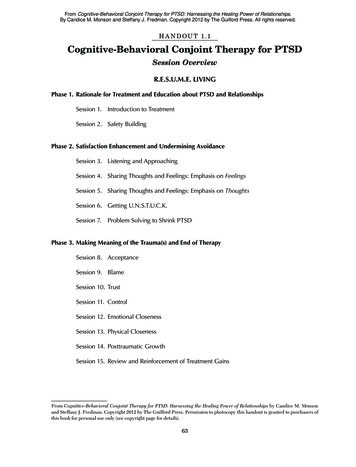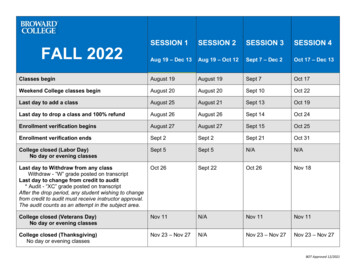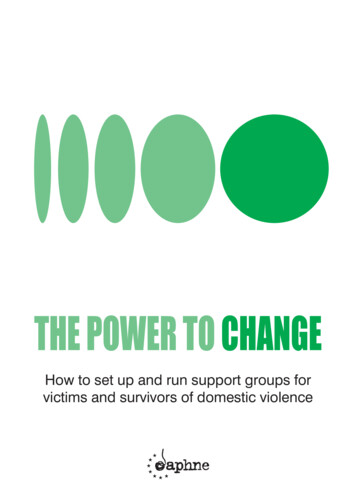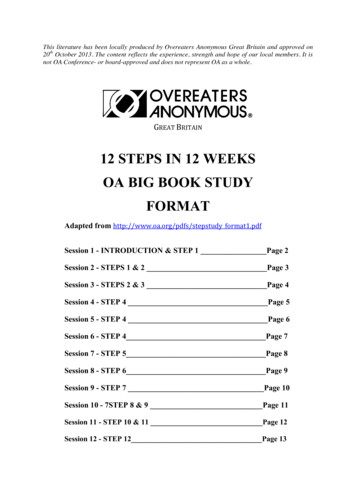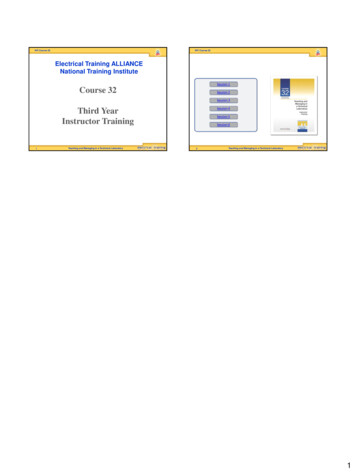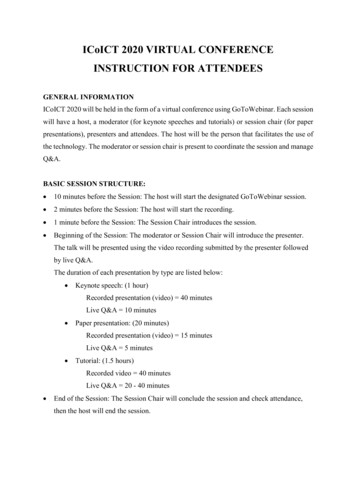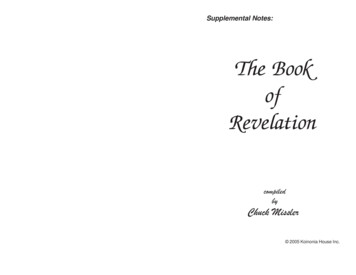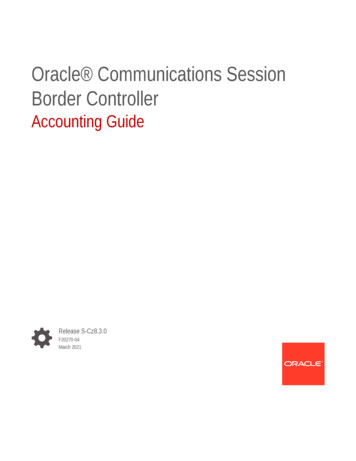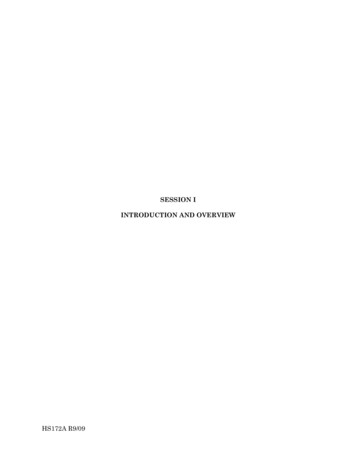
Transcription
SESSION IINTRODUCTION AND OVERVIEWHS172A R9/091
SESSION IINTRODUCTION AND OVERVIEWUpon successfully completing this session, the participant will be able to: State the goals and objectives of the course. Describe the course schedule and activities. Demonstrate their pre-training knowledge of course topics.CONTENT SEGMENTSLEARNING ACTIVITIESA.Welcoming Remarks and Objectives Instructor-Led PresentationsB.Administrative DetailsC.Pre-TestHS172A R9/09 Written Examination2
DWI DETECTION AND STANDARDIZED FIELD SOBRIETY TESTINGTRAINING GOALS AND OBJECTIVES1.Ultimate GoalTo increase deterrence of DWI violations, and thereby reduce the number of crashes,deaths and injuries caused by impaired drivers.2.3.Enforcement-Related Goalsa.Understand enforcement's role in general DWI deterrence.b.Understand detection phases, clues and techniques.c.Understand requirements for organizing and presenting testimonial anddocumentary evidence in DWI cases.Job Performance ObjectivesAs a result of this training, participants will become significantly better able to:4.a.Recognize and interpret evidence of DWI violations.b.Administer and interpret Standardized Field Sobriety Tests.c.Describe DWI evidence clearly and convincingly in written reports and verbaltestimony.Enabling ObjectivesIn pursuit of the job performance objectives, participants will come to:a.Understand the tasks and decisions of DWI detection.b.Recognize the magnitude and scope of DWI-related crashes, deaths, injuries,property loss and other social aspects of the DWI problem.c.Understand the deterrence effects of DWI enforcement.d.Understand the DWI enforcement legal environment.HS172A R9/093
e.Know and recognize typical vehicle maneuvers and human indicators symptomaticof DWI that are associated with initial observation of vehicles in operation.f.Know and recognize typical reinforcing maneuvers and indicators that come to lightduring the stopping sequence.g.Know and recognize typical sensory and other clues of alcohol and/or other drugimpairment that may be seen during face-to-face contact with DWI subjects.h.Know and recognize typical behavioral clues of alcohol and/or other drugimpairment that may be seen during the subject's exit from the vehicle.i.Understand the role and relevance of psychophysical testing in pre-arrest screeningof DWI subjects.j.Understand the role and relevance of preliminary breath testing in pre-arrestscreening of DWI subjects.k.Know and carry out appropriate administrative procedures for validated dividedattention psychophysical tests.l.Know and carry out appropriate administrative procedures for the Horizontal GazeNystagmus test.m. Know and recognize typical clues of alcohol and/or other drug impairment that maybe seen during administration of the Standardized Field Sobriety Tests.5.n.Understand the factors that may affect the accuracy of preliminary breath testingdevices.o.Understand the elements of DWI prosecution and their relevance to DWI arrestreporting.p.Choose appropriate descriptive terms to convey relevant observations of DWIevidence.q.Write clear, descriptive narrative DWI arrest reports.Additional Training Goals and Objectivesa.If the four-hour (Introduction to Drugs That Impair) or eight-hour (Drugs ThatImpair Driving) modules are presented as part of the SFST training program, thegoals and objectives for those modules are listed in the appropriate manuals.HS172A R9/094
GLOSSARY OF TERMSALVEOLAR BREATH - Breath from the deepest part of the lung.BLOOD ALCOHOL CONCENTRATION (BAC) - The percentage of alcohol in a person'sblood.BREATH ALCOHOL CONCENTRATION (BrAC) - The percentage of alcohol in a person’sbreath, taken from deep in the lungs.CLUE - Something that leads to the solution of a problem.CUE - A reminder or prompting as a signal to do something. A suggestion or a hint.DIVIDED ATTENTION TEST - A test which requires the subject to concentrate on bothmental and physical tasks at the same time.DWI/DUI - The acronym "DWI" means driving while impaired and is synonymous with theacronym "DUI", driving under the influence or other acronyms used to denote impaireddriving. These terms refer to any and all offenses involving the operation of vehicles bypersons under the influence of alcohol and/or other drugs.DWI DETECTION PROCESS - The entire process of identifying and gathering evidence todetermine whether or not a subject should be arrested for a DWI violation. The DWIdetection process has three phases:Phase One - Vehicle In MotionPhase Two - Personal ContactPhase Three - Pre-arrest ScreeningEVIDENCE - Any means by which some alleged fact that has been submitted toinvestigation may either be established or disproved. Evidence of a DWI violation may be ofvarious types:a.b.c.d.e.Physical (or real) evidence: something tangible, visible, or audible.Well established facts (judicial notice).Demonstrative evidence: demonstrations performed in the courtroom.Written matter or documentation.Testimony.FIELD SOBRIETY TEST - Any one of several roadside tests that can be used to determinewhether a subject is impaired.HIPPUS – A rhythmic change in the pupil size of the eyes, as they dilate and constrictobserved only in darkness independent of changes in light intensity, accommodation(focusing) or other forms of sensory stimulation. Normally only observed with specializedequipment.HS172A R9/095
HORIZONTAL GAZE NYSTAGMUS (HGN) - An involuntary jerking of the eyes as theygaze toward the side.ILLEGAL PER SE - Unlawful in and of itself. Used to describe a law which makes it illegalto drive while having a statutorily prohibited Blood Alcohol Concentration.NYSTAGMUS - An involuntary jerking of the eyes.ONE-LEG STAND (OLS) - A divided attention field sobriety test.PERSONAL CONTACT - The second phase in the DWI detection process. In this phase theofficer observes and interviews the driver face to face; determines whether to ask the driverto step from the vehicle; and observes the driver's exit and walk from the vehicle.PRE-ARREST SCREENING - The third phase in the DWI detection process. In this phasethe officer administers field sobriety tests to determine whether there is probable cause toarrest the driver for DWI, and administers or arranges for a preliminary breath test.PRELIMINARY BREATH TEST (PBT) - A pre-arrest breath test administered duringinvestigation of a possible DWI violator to obtain an indication of the person's blood alcoholconcentration.PSYCHOPHYSICAL - "Mind/Body." Used to describe field sobriety tests that measure aperson's ability to perform both mental and physical tasks.PUPILLARY UNREST – The continuous, irregular change in the size of the pupils that maybe observed under room or steady light conditions.REBOUND DILATION – A period of pupillary constriction followed by a period of pupillarydilation where the pupil steadily increases in size.STANDARDIZED FIELD SOBRIETY TEST BATTERY - A battery of tests, Horizontal GazeNystagmus, Walk-and-Turn, and One-Leg Stand, administered and evaluated in astandardized manner to obtain validated indicators of impairment based on NHTSAresearch.TIDAL BREATH - Breath from the upper part of the lungs and mouth.VEHICLE IN MOTION - The first phase in the DWI detection process. In this phase theofficer observes the vehicle in operation, determines whether to stop the vehicle, andobserves the stopping sequence.VERTICAL GAZE NYSTAGMUS - An involuntary jerking of the eyes ( up and down) whichoccurs when the eyes gaze upward at maximum elevation. The jerking should be distinctand sustained.WALK-AND-TURN (WAT) - A divided attention field sobriety test.HS172A R9/096
SESSION IIDETECTION AND GENERAL DETERRENCEHS172A R9/091
SESSION IIDETECTION AND GENERAL DETERRENCEUpon successfully completing this session, the participant will be able to: Describe the frequency of DWI violations and crashes. Define General Deterrence. Describe the Relationship between Detection and General Deterrence. Describe a brief history of alcohol; Identify common types of alcohols; Describe the physiologic processes of absorption, distribution and eliminationof alcohol in the human body;CONTENT SEGMENTSLEARNING ACTIVITIESA.The DWI Problem Instructor-Led PresentationsB.The Concept of General Deterrence Reading AssignmentsC.Relating Detection to Deterrence PotentialD.Evidence of Effective Detection andEffective DeterrenceE.Physiology of AlcoholHS172A R9/092
DWI DETERRENCE: AN OVERVIEWEach year, tens of thousands of people die in traffic crashes. Throughout the nation, alcoholis the major contributor to traffic fatalities. In 2002, alcohol-related fatalities rose to 17,419,representing 41 percent of all traffic fatalities. (NHTSA 2002 FARS data)Impaired drivers are more likely than other drivers to take excessive risks such as speedingor turning abruptly. Impaired drivers also are more likely than other drivers to have slowedreaction times. They may not be able to react quickly enough to slow down before crashingand are less likely to wear seatbelts. On the average, two percent of drivers on the road atany given time are DWI. DWI violations and crashes are not simply the work of a relativelyfew "problem drinkers" or "problem drug users." Many people commit DWI, at leastoccasionally. In a 1991 Gallup Survey of 9,028 drivers nationwide, 14% of the respondentsreported they drove while close to or under the influence of alcohol within the lastthree months.It is conservatively estimated that the typical DWI violator commits that offense about 80times per year. In other words, the average DWI violator drives while under the influenceonce every four or five nights.THE PROBLEM OF DWIHOW WIDESPREAD IS DWI?While not all of those who drive after drinking have a BAC of 0.08/0.10 or more, thepresumptive or illegal per se limit for DWI in many states, some drivers do have BACs inexcess of these limits.A frequently quoted, and often misinterpreted, statistic places the average incidence of DWIat one driver in fifty. Averaged across all hours of the day and all days of the week, twopercent of the drivers on the road are DWI. That 1 in 50 figure is offered as evidence that arelatively small segment of America's drivers the so called "problem" group account for themajority of traffic deaths. There's nothing wrong with that figure as a statistical average,but police officers know that at certain times and places many more than two percent ofdrivers are impaired. National Highway Traffic Safety Administration research suggeststhat during the late night, weekend hours, as many as ten percent of drivers on the roadsmay be DWI. On certain holiday weekends, and other critical times, the figure may go evenhigher.HOW MANY? HOW OFTEN?The issue of how many DWIs are on the road at any given time is an important factor inmeasuring the magnitude of the problem. However, from an overall traffic safetyperspective, the more important issue may be the number of drivers who ever commit DWI.Just how widespread is this violation? In enforcement terms, how many people do we needto deter?HS172A R9/093
Clearly, it is more than one in fifty. Although it may be true that, on the average, twopercent of drivers are DWI at any given time, it certainly is not the same two percent everytime. It is even more than one in ten. Not everyone who commits DWI is out on the roadimpaired every Friday and Saturday night. Some of them, at least, must skip an occasionalweekend. Thus, the ten percent who show up, weekend after weekend, in the Friday andSaturday statistics must come from a larger pool of violators, each of whom "contributes" tothe statistics on some nights, but not necessarily on all nights.An analysis of BAC roadside survey data suggests that the average DWI violator commitsthe violation approximately 80 times each year. Undoubtedly, there are some who driveimpaired virtually everyday; others commit the violation less often. It is likely that at leastone quarter of all American motorists drive while impaired at least once in their lives. Thatfigure falls approximately midway between the 55 percent of drivers who at leastoccasionally drive after drinking and the ten percent of weekend, nighttime drivers whohave BACs above the so called legal limit.1.Borkenstein, R.F., et al, Role of Drinking Driver in Traffic Accidents. Bloomington IN:Department of Police Administration, Indiana University, March 1964.2.Alcohol Highway Safety Workshop, Participant's Workbook Problem Status. NHTSA,1980.3.DWI Law Enforcement Training: Instructor's Manual. NHTSA. August 1974. P.139.Our estimated one in four drivers include everyone who drives impaired everyday, as wellas everyone who commits the violation just once and never offends again; and it includeseveryone in between. In short, it includes everyone who ever runs the risk of being involvedin a crash while impaired.SOCIETY'S PROBLEM AND THE SOLUTIONIt really doesn't matter whether this one in four estimate is reasonably accurate (in fact, itis probably low). The fact is that far more than two percent of American drivers activelycontribute to the DWI problem. DWI is a crime committed by a substantial segment ofAmericans. It has been and remains a popular crime; one that many people from all walksand stations of life commit. DWI is a crime that can be fought successfully only through asocietal approach of comprehensive community-based programs.GENERAL DETERRENCEOne approach to reducing the number of drinking drivers is general deterrence of DWI.General deterrence of DWI is based in the driving public's fear of being arrested. If enoughviolators come to believe that there is a good chance that they will get caught, at least someof them will stop committing DWI at least some of the time. However, unless there is a realrisk of arrest, there will not be much fear of arrest.Law enforcement officers must arrest enough violators enough of the time to convince thegeneral public that they will get caught, sooner or later, if they continue to drive whileimpaired.HS172A R9/094
How many DWI violators must be arrested in order to convince the public that there is areal risk of arrest for DWI? Several programs have demonstrated that significantdeterrence can be achieved by arresting one DWI violator for every 400 DWI violationscommitted. Currently, however, for every DWI violator arrested, there are between 500 and2,000 DWI violations committed. (See Exhibit 2-1) When the chances of being arrested areone in two thousand, the average DWI violator really has little to fear.EXHIBIT 2-1Chances of a DWI violator being arrested are as low as 1 in 2000.Why is the DWI arrest to violations ratio (1:2000) so low? There are three noteworthyreasons. DWI violators vastly outnumber police officers. It is not possible to arrest everydrinking driver each time they commit DWI. Some officers are not highly skilled at DWI detection. They fail to recognize andarrest many DWI violators. Some officers are not motivated to detect and arrest DWI violators.SIGNIFICANT FINDINGSIn a 1975 study conducted in Fort Lauderdale, Florida, only 22 percent of traffic violatorswho were stopped with BACs between 0.10 and 0.20 were arrested for DWI. The remainderwere cited for other violations, even though they were legally impaired. In this study breathtests were administered to the violators by researchers after the police officers hadcompleted their investigations. The officers failed to detect 78 percent of the DWI violatorsthey investigated.The implication of this study, and of other similar studies, is that for every DWI violatoractually arrested for DWI, three others are contacted by police officers, but are not arrestedfor DWI. (See Exhibit 2-2.) It is clear that significant improvement in the arrest rate couldHS172A R9/095
be achieved if officers were more skilled at DWI detection.EXHIBIT 2-2Several enforcement programs have succeeded in achieving significant DWI deterrence.Consider, for example, the three year intensive weekend DWI enforcement program inStockton, California. Under that program: arrests increased 500 percent;weekend nighttime crashes decreased 34 percent;the proportion of nighttime weekend drivers legally under the influence droppedfrom nine percent to six percent.Improved DWI detection can be achieved in virtually every jurisdiction in the country. Thekeys to success are police officers who are: skilled at DWI detection;willing to arrest every DWI violator who is detected;supported by their agencies in all aspects of this program, from policy throughpractical application.THE SOLUTIONSTHE ULTIMATE GOAL: CHANGING BEHAVIORWhat must comprehensive community based DWI programs seek to accomplish?Ultimately, nothing less than fundamental behavioral change, on a widespread basis. Thegoal is to encourage more Americans to: avoid committing DWI, either by avoiding or controlling drinking prior to driving orby selecting alternative transportation. intervene actively to prevent others from committing DWI (for example, putting intopractice the theme "friends don't let friends drive drunk");HS172A R9/096
avoid riding with drivers who are impaired.The final test of the value of DWI countermeasures on the national, state and local levels iswhether they succeed in getting significantly more people to modify their behavior. Theprograms also pursue other more immediate objectives that support or reinforce theultimate goal. However, the ultimate goal is to change driving while impaired to anunacceptable form of behavior at all levels.PURSUING THE GOAL: TWO APPROACHESHow can we bring about these changes in behavior? How can we induce more people toavoid DWI violations, prevent others from drinking and driving, and avoid becoming passive"statistics" by refusing to ride with drinking drivers? Basically, there are two generalapproaches that must be taken to achieve this goal. One: prevention -- gives promise of theultimate, lasting solution to the DWI problem; but it will require a substantial amount oftime to mature fully. The other -- deterrence -- only offers a partial or limited solution, butit is available right now.PREVENTION: THE ULTIMATE SOLUTIONDWI countermeasures that strive for the ultimate achievement of drinking and drivingbehavioral changes have been grouped under the label "Prevention." There are many kindsof DWI preventive activities. Some are carried out by and in our schools, some through themass media, some through concerned civic groups, and so forth. The various preventiveefforts focus on different specific behaviors and address different target groups. However,they seek to change drinking and driving behavior by promoting more positive attitudes andby fostering a set of values that reflects individual responsibilities toward drinking anddriving.Preventive countermeasures seek society's acceptance of the fact that DWI is wrong. Somepeople believe that drinking and driving is strictly an individual's personal business; that itis up to each person to decide whether or not to accept the risk of driving after drinking.Preventive activities try to dispel that outmoded and irresponsible belief. Instead, theypromote the idea that no one has the right to endanger others by drinking and driving, or torisk becoming a burden (economically and otherwise) to others as a result of injuriessuffered while drinking and driving. Realistically, everyone has an obligation not only tocontrol their own drinking and driving, but also to speak up when others are about tocommit the violation. Only when all of society views DWI as a negative behavior thatcannot be tolerated or condoned, will the public's behavior begin to change. That is thelong-term solution.DWI DETERRENCEDETERRENCE: THE INTERIM SOLUTIONDWI countermeasures that seek a short-cut to the ultimate goal of behavioral changegenerally are labeled "Deterrence." Deterrence can be described as negative reinforcement.Some deterrence countermeasures focus primarily on changing individual drinking anddriving behavior while others seek to influence people to intervene into others' drinking andHS172A R9/097
driving decisions.The key feature of deterrence is that it strives to change DWI behavior without dealingdirectly with the prevailing attitudes about the rightness or wrongness of DWI. Deterrenceuses a mechanism quite distinct from attitudinal change: fear of apprehension andapplication of sanctions.THE FEAR OF BEING CAUGHT AND PUNISHEDLarge scale DWI deterrence programs try to control the DWI behavior of the driving publicby appealing to the public's presumed fear of being caught. Most actual or potential DWIviolators view the prospect of being arrested with extreme distaste. For some, the arrest,with its attendant handcuffing, booking, publicity and other stigmatizing and traumatizingfeatures, is the thing most to be feared. For others, it is the prospective punishment (jail,stiff fine, etc.) that causes most of the concern. Still others fear most the long-term costsand inconvenience of a DWI arrest: the license suspension and increased premiums forautomobile insurance. For many violators the fear probably is a combination of all of these.Regardless, if enough violators are sufficiently fearful of DWI arrest, some of them willavoid committing the violation at least some of the time. Fear by itself will not change theirattitudes; if they do not see anything inherently wrong with drinking and driving in the firstplace, the prospect of arrest and punishment will not help them see the light. However, fearsometimes can be enough to keep them from putting their anti-social attitudes into practice.This type of DWI deterrence, based on the fear of being caught, is commonly called generaldeterrence. It applies to the driving public generally and presumably affects the behavior ofthose who have never been caught. There is an element of fear of the unknown at workhere.Another type of DWI deterrence, called specific deterrence, applies to those who have beencaught and arrested. The typical specific deterrent involves some type of punishment,perhaps a fine, involuntary community service, a jail term or action against the driver'slicense. The punishment is imposed in the hope that it will convince the specific violatorthat there is indeed something to fear as a result of being caught, and to emphasize that ifthere is a next time, the punishment will be even more severe. It is the fear of the knownthat comes into play in this case.The concept of DWI deterrence through fear of apprehension or punishment seems sound.But will it work in actual practice? The crux of the problem is this: If the motoring public isto fear arrest and punishment for DWI, they must perceive that there is an appreciable riskof being caught and convicted if they commit the crime. If actual and potential DWIviolators come to believe that the chance of being arrested is minimal, they will quickly losewhatever fear of arrest they may have felt.Enforcement is the mechanism for creating and sustaining a fear of being caught for DWI.No specific deterrence program can amount to much, unless police officers arrest largenumbers of violators; no punishment or rehabilitation program can affect behavior on alarge scale unless it is applied to many people. General deterrence depends on enforcement-- the fear of being caught is a direct function of the number of people who are caught.HS172A R9/098
Obviously, the police alone cannot do the job. Legislators must supply laws that the policecan enforce. Prosecutors must vigorously prosecute DWI violators, and the judiciary mustadjudicate fairly and deliver the punishments prescribed by law. The media must publicizethe enforcement effort and communicate the fact that the risk is not worth the probableoutcome. Each of these elements plays a supportive role in DWI deterrence.HOW GREAT A RISK IS THERE?The question now is, are violators afraid of being caught? More importantly, should they beafraid? Is there really an appreciable risk of being arrested if one commits DWI?The answer to all of these questions unfortunately is: probably not. In most jurisdictions,the number of DWI arrests appears to fall short of what would be required to sustain apublic perception that there is a significant risk of being caught.Sometimes, it is possible to enhance the perceived risk, at least for a while, throughintensive publicity. However, media "hype" without intensified enforcement has never beenenough to maintain the fear of arrest for very long.HOW MUCH SHOULD THE PUBLIC FEAR?We can draw some reasonable estimates of DWI enforcement intensity, based on what weknow and on certain assumptions we have already made. Suppose we deal with a randomsample of 100 Americans of driving age. If they come from typical enforcement jurisdictions,chances are that exactly one of them will be arrested for DWI in any given year: our annualDWI arrests, in most places, equal about one percent of the number of drivers in thepopulation. That is one arrest out of 100 drivers during one year; however, how many DWIviolations do those drivers commit? Recall our previous estimates that some 25 percent ofAmerica's drivers at least occasionally drive while under the influence, and that the averageviolator commits DWI 80 times each year. Then, our sample of 100 drivers includes 25 DWIviolators who collectively are responsible for 2,000 DWI violations yearly.CHANGING THE ODDSIf an arrest/violation ratio of 1 in 2,000 is not enough to make deterrence work, is it thenreasonable to think that we can ever make deterrence work? After all, if we doubled DWIarrests to 1 in 1,000, we would still be missing 999 violators for every one we managed tocatch. If we increased arrests ten-fold, to 1 in 200, 199 would escape for every one arrested.How much deterrence would that produce?Surprisingly, it would probably produce quite a bit. We don't have to arrest every DWIoffender every time in order to convince them that they have something to fear. We onlyhave to arrest enough of them enough of the time to convince many of them that it canhappen to them. As the arrest rate increases, the odds are that it will happen to themeventually. The law of averages (or cumulative probability) will catch up with them, andsooner than we might at first expect.The statistics below display the cumulative probability (as a percentage) of being arrested atleast once during the course of one, two or three years as a function of the arrest rate on anyHS172A R9/099
given night. These statistics are based on the assumption that the average violator commitsDWI 80 times each year.Percent of violators arrested after.Nightly Arrest RateOne YearTwo YearsThree Years1 in 20003.9%7.7%11.3%1 in 10007.7%14.8%21.3%1 in 50014.8%27.4%38.2%1 in 20033.0%55.2%70.0%Clearly, the chances of being caught accumulate very quickly as the arrest/violation ratioincreases. If we could maintain a ratio of one arrest in every 500 violations (a level ofenforcement currently maintained in some jurisdictions), then by the time one year haspassed, slightly more than one of every seven people (14.8%) who have committed DWIduring that year will have been arrested at least once. It probably is a high enough chanceto get the attention -- and fear -- of many violators. If we could achieve an arrest ratio of 1in 200 (a level attainable by officers skilled in DWI detection) we will arrest fully one-thirdof all DWI violators at least once every year, and we will arrest more than half of them bythe time two years have gone by.DWI DETECTION: THE KEY TO DETERRENCECAN IT BE DONE, AND WILL IT WORK?Is there any evidence that a practical and realistic increase in DWI enforcement activity willinduce a significant degree of general deterrence and a corresponding change in DWIbehavior? Yes there is.As early as 1975, in the city of Stockton, California, a study showed that the city's totalnumber of DWI arrests (700) were considerably less than one percent of the areas licensednumber of drivers (130,000). The implication here was that Stockton police were onlymaintaining the arrest/violation ration of 1-2,000, or less. In addition, roadside surveys onFriday and Saturday nights disclosed that nine percent of the drivers were operating withBAC's of 0.10 or higher.Then things changed. Beginning in 1976 and continuing at planned intervals through thefirst half of 1979, Stockton police conducted intensive DWI enforcement on weekend nights.The officers involved were extensively trained. The enforcement effort was heavilypublicized and additional equipment (PBTs and cassette recorders) was made available.The police effort was closely coordinated with the District Attorney's office, the CountyProbation office, and other allied criminal justice and safety organizations. All this paid off.By the time the project came to a close (in 1979) DWI arrests had increased by over 500percent, and weekend nighttime collisions had decreased by 34 percent, and the number ofoperators committing DWI dropped one-third.HS172A R9/0910
Since the historical Stockton study numerous states have conducted similar studies todetermine the degree of effect that DWI arrests would have on alcohol related fatalities ingeneral, and total fatalities in particular. Most of these studies were conducted between1978 and 1986.The results of these studies graphically illustrated in each state that when the number ofarrests for DWI increased, the percent of alcohol related fatalities decreased. Further, theresults of a study conducted in Florida from 1981 - 1983, showed that when DWI arrests perlicensed driver increased, total fatalities decreased (12-month moving average).DETECTION: THE KEY TO DETERRENCEIt is important to understand how increased DWI enforcement can affect deterrence.Deterrence can vastly exceed the level of enforcement officers achieve on any given night.True, weekend DWI arrests can increase by as much as 500 percent, as in the Stocktonstudy. However,
DWI DETECTION AND STANDARDIZED FIELD SOBRIETY TESTING TRAINING GOALS AND OBJECTIVES 1. Ultimate Goal To increase deterrence of DWI violations, and thereby reduce the number of crashes, deaths and injuries caused by impaired drivers. 2. Enforcement-Related Goals a. Understand enforcement's role in general DWI deterrence. b.

